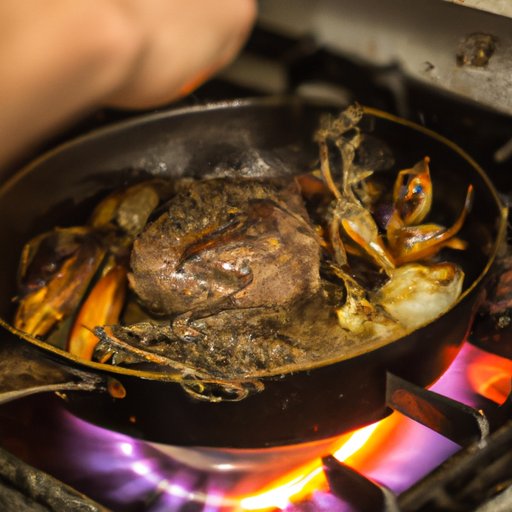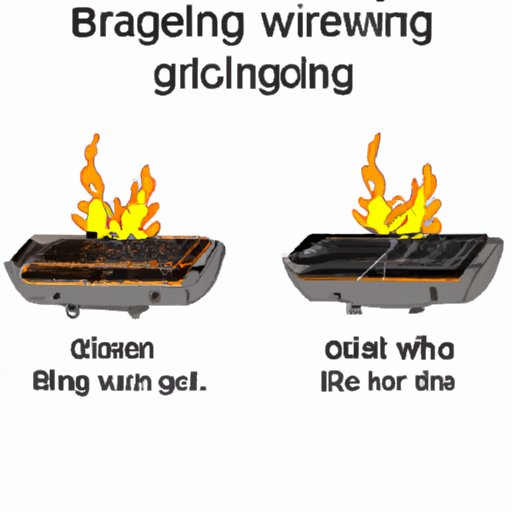
I. Introduction
Broiling is a popular cooking method that involves exposing food to high heat from a direct flame, similar to grilling. This method can result in savory and juicy steaks, chicken, and vegetables, making it a favorite for many home chefs. The purpose of this article is to guide readers through the process of broiling and provide them with the necessary skills to perfect this cooking technique.
II. Broiling 101: A Beginner’s Guide
Broiling is a cooking technique that involves exposing food to direct heat from the top element of an oven. This method cooks food quickly while creating a delicious caramelized crust. To get started with broiling, you’ll need to pick the right cuts of meat and vegetables, set up your broiler, and follow a few easy steps.
A. Definition of Broiling
Broiling is a cooking method that involves cooking food in direct contact with high heat. It’s a quick and efficient way to cook food, and it’s great for creating a crispy texture on the outside of food while keeping the inside juicy and tender.
B. Understanding How Broiling Works
Broiling involves using a broiler, which is an oven setting that heats the top element of the oven. This element is usually a powerful gas or electric burner that sends intense heat directly onto the food, cooking it quickly and evenly.
C. Choosing the Right Cuts of Meat and Vegetables for Broiling
When broiling meat, it’s important to choose cuts that are tender and have a good amount of marbling. Ribeye, sirloin, and flank steak are all excellent options. For chicken, boneless, skinless chicken breasts work well. Vegetables like asparagus and bell peppers are also great for broiling.
D. Setting Up Your Broiler and Necessary Equipment
Before broiling, set your oven to the broil setting and adjust the oven rack to about 6 inches from the top element. A broiler pan is recommended for cooking meat and vegetables, and a meat thermometer is essential for monitoring the internal temperature of the food.
E. Step-by-Step Instructions for Broiling Steak, Chicken, and Vegetables
Season your meat and vegetables with salt, pepper, and any other spices or herbs you prefer. Place your food on the broiler pan and place the pan in the oven. Cook your meat or vegetables for a few minutes, then flip them over and cook for an additional few minutes until done.
III. Mastering the Broiler: Tips and Tricks
To make the most of your broiling technique, there are some important tips you should keep in mind.
A. Preparing Your Meat for Broiling
To get the best results when broiling meat, it’s essential to prepare it correctly. Tenderize your meat if necessary, and season it before cooking. Allow your meat to rest after cooking, so the juices can settle and keep it moist and tender.
B. Proper Temperature Control for Consistent Results
Consistent temperature control is essential when broiling. Keep an eye on the food while it’s cooking, and adjust the temperature if necessary to avoid overcooking.
C. Creating a Browning Effect for Added Flavor
For maximum flavor, allow your meat to brown nicely on both sides. This caramelization creates an intense, sweet flavor that is perfect for savory dishes.
D. The Benefits of Using a Broiler Pan
Broiler pans are specifically designed to expose meat and vegetables to direct heat while catching any drippings and grease. This makes for a cleaner and more controlled cooking experience, producing better results in the end.
E. How to Avoid Common Broiling Mistakes
Common mistakes when broiling include leaving the oven door open, failing to monitor the temperature, and overcooking the food. Be sure to keep a close eye on your food, and experiment to find what works best for you.
IV. What to Know Before You Broil: Safety Precautions and Equipment Recommendations
A. Safety Tips for Using a Broiler
When using a broiler, it’s important to keep safety in mind. Always have a fire extinguisher nearby just in case, and never leave the oven unattended while the broiler is on. Make sure that flammable items are kept far away from the oven.
B. Choosing the Safest Broiler for Your Kitchen
When shopping for a broiler, look for models that have safety features such as automatic shut off, oven lights, and sturdy construction. Avoid broilers with plastic parts that are prone to melting and avoid placing broilers on flammable surfaces.
C. Must-Have Kitchen Equipment for Successful Broiling
Having the right equipment is essential for successful broiling. A broiler pan, meat thermometer, and tongs are all essential tools for broiling success. You can also invest in an oven mitt and a splatter screen to make the process easier and safer.
D. Safety Practices for Cleaning and Maintaining Your Broiler
When cleaning your broiler, be sure to turn off the oven and allow the elements to cool before handling. Use a damp cloth to wipe down the interior and avoid using harsh cleaning chemicals that could damage the oven. It’s also a good idea to check the oven regularly for any signs of damage, such as frayed wires or loose connections.
V. Up Your Broiling Game: Creative Seasoning and Marinade Ideas
A. Essential Spices and Herbs for Broiling
Adding the right spices and herbs to your meat or vegetables can really enhance the flavors. Some essential spices for broiling include garlic, onion powder, smoked paprika, and cumin. Try out different herb combinations to find what works best for you.
B. How to Make Your Own Marinades
Marinades can be used to add extra flavor and tenderness to your meat. Some popular marinade ingredients include olive oil, vinegar, soy sauce, and honey. Experiment with different ingredients and marinade times to find the perfect combination.
C. Pairing Flavors with Meats and Vegetables
The right flavor combination can really elevate your broiled dishes. For chicken, try combining herbs like thyme, rosemary, and sage. For beef, consider a mix of pepper, garlic, and onion powder. Vegetables like zucchini and carrots pair well with Italian herbs like oregano and basil.
D. Exploring Global Cuisine with Broiling Techniques
Broiling isn’t just for American cuisine. You can experiment with different spices and flavors from around the world to create delicious broiled dishes. Try making Korean-style beef or broiled Indian chicken for a new and exciting flavor experience.
VI. Timing Is Everything: How to Determine the Perfect Broiling Time
A. Factors That Influence Broiling Time
The thickness of your meat and the desired doneness are the main factors that will influence broiling time. Keep an eye on the internal temperature of your meat and adjust the broiling time accordingly.
B. Tips for Knowing When Meat Is Cooked to Perfection
The best way to know if your meat is cooked to perfection is to use a meat thermometer. For rare steak, pull it off the heat when it reached an internal temperature of 125°F. For chicken, the internal temperature should be 165°F.
C. How to Adjust Cooking Times for Larger or Thicker Cuts of Meat
For larger or thicker cuts of meat, you may need to adjust the broiling time or reduce the heat slightly to avoid overcooking the outside while the inside is still raw. Use a lower temperature and a longer cooking time to ensure even cooking throughout the meat.

VII. Broiling vs. Grilling: Understand the Differences
A. Comparison of Broiling and Grilling Methods
Broiling and grilling are similar because both expose food to high heat. However, broiling is done inside the oven, while grilling is done outside on a grill or barbecue. Grilling allows for a smokier flavor and requires more outdoor equipment while broiling is great for quick indoor cooking.
B. Pros and Cons of Broiling vs. Grilling
Grilling is often preferred for the flavor and the experience, while broiling is great for quick cooking and convenience. Broiling is often a better choice when weather conditions aren’t suitable for outdoor grilling.
C. When to Choose Broiling Over Grilling and Vice Versa
If you’re looking for a quick and convenient way to cook your food, broiling is a great option. If you want to enjoy the outdoors and the smoky flavor of grilled food, grilling is the way to go. Consider your preferences and the weather conditions before deciding which to use.
VIII. Cleaning and Maintaining Your Broiler
A. How to Clean a Broiler after Each Use
When cleaning your broiler, make sure to follow the manufacturer’s instructions on how to safely clean the oven. Use a damp cloth and mild soap to wipe down the inside of the oven. Avoid using harsh chemicals that could damage the oven or burn off the non-stick coating.
B. Recommended Cleaning Solutions
Vinegar and baking soda solutions can be used to clean your broiler safely. These natural cleaning agents dissolve grease and grime without harming the oven’s interior.
C. Tips for Keeping Your Broiler in Top Condition
Keeping your broiler in top condition involves regular cleaning and maintenance. Check for any frayed wires or loose connections. Also, make sure that the oven is level and not damaged in any way. Always replace any damaged or faulty parts immediately.
D. Troubleshooting Common Broiler Issues
If you’re having trouble with your broiler, check for any obvious issues like a blown fuse or a damaged heating element. Also, be sure to keep the oven clean and free of debris that could impact performance.
IX. Conclusion
A. Recap of the Main Points Covered in the Article
Broiling is a popular cooking method that involves cooking food in direct contact with high heat. A great starter guide to broiling includes a definition of broiling, how to understand how broiling works, how to choose the right cuts of meat and vegetables for broiling, how to set up a broiler and use necessary equipment, and an easy recipe for broiling steak, chicken, and vegetables. After mastering the basics, it’s important to learn the tips and tricks, safety precautions, and cleaning routines necessary for perfect broiling.
B. Encouragement to Try Broiling at Home
Broiling is an easy and versatile cooking technique that can be used to create delicious meals at home. By following a few simple tips and tricks, home cooks can perfect their broiling skills and prepare flavorful and juicy meals in no time.
C. Final Thoughts on the Benefits of Broiling
Broiling offers many benefits, including fast cooking times, minimal cleanup, and a delicious caramelized flavor. It’s a great way to enjoy grilled foods, even when outdoor grilling is not possible.
D. Call-to-Action for Readers to Leave Feedback or Share Their Own Broiling Tips
If you’ve tried broiling at home, we want to hear from you! Leave a comment below with your favorite tips and tricks, or share your own broiling recipe.




